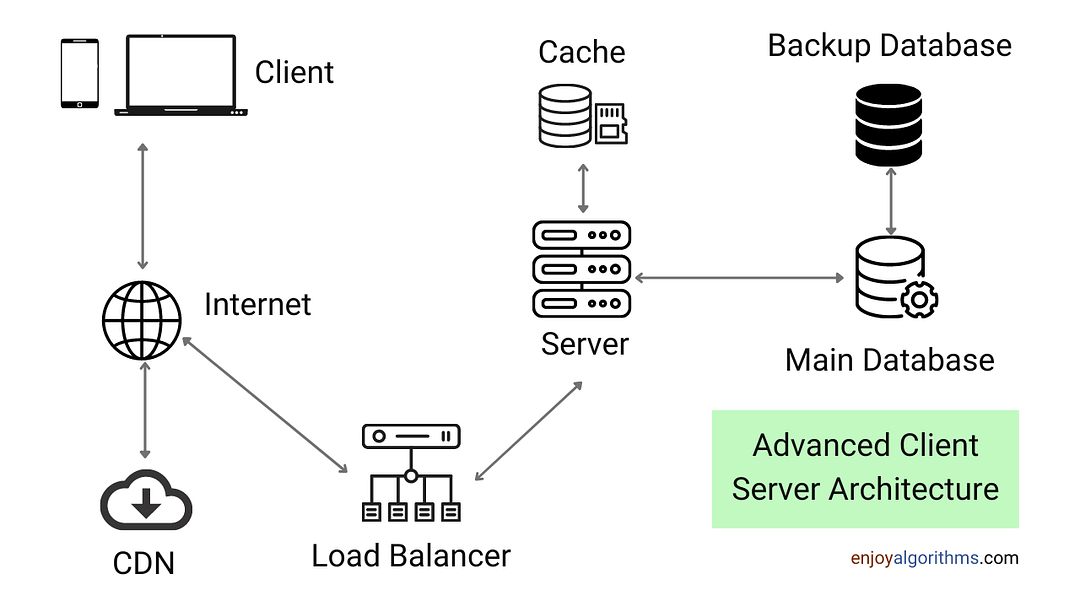Client Server Architecture:
 Manish Kumar
Manish Kumar
Introduction to Client-Server Architecture:
Client-server architecture is a model for organizing distributed computing in which tasks or workloads are divided between service requesters (clients) and service providers (servers). This architectural model is fundamental to modern networked computing, enabling efficient communication and resource sharing across networks. Here's a detailed exploration of the key components, principles, and characteristics of client-server architecture:
1. Components of Client-Server Architecture:
Clients: These are the end-user devices or software applications that initiate requests for services or resources from servers. Clients can range from desktop computers, laptops, smartphones, tablets, to IoT devices and software applications.
Servers: Servers are computers, software applications, or dedicated hardware devices that provide services or resources to clients. They listen for incoming requests, process them, and send back responses. Servers are typically more powerful machines optimized for handling multiple client requests simultaneously.
2. Principles of Communication:
Protocol: Communication between clients and servers occurs via predefined protocols such as HTTP, TCP/IP, FTP, SMTP, etc. These protocols govern the format, rules, and sequence of messages exchanged between clients and servers.
Request-Response Model: Clients initiate communication by sending requests to servers. Servers process these requests and return responses back to the clients. This request-response model forms the basis of interaction in client-server architecture.
3. Characteristics of Client-Server Architecture:
Scalability: Client-server architecture supports scalability by allowing the addition of more clients or servers to the system as demand grows. It enables horizontal scaling by distributing the workload across multiple servers.
Centralized Control: Servers typically control access to resources and enforce security policies, providing a centralized point of control. This centralized control facilitates management, monitoring, and enforcement of security measures.
Reliability and Availability: Servers often incorporate redundancy, failover mechanisms, and load balancing to ensure high availability and reliability of services. Redundant servers and data backups minimize the risk of service disruptions and data loss.
Interoperability: Client-server architecture facilitates interoperability by allowing clients and servers to be implemented using different technologies and platforms. As long as they adhere to the specified communication protocols, clients and servers can interact seamlessly.
4. Examples of Client-Server Applications:
Web Servers: Serve web pages and content to web browsers (clients) over the HTTP protocol. Examples include Apache HTTP Server, Nginx, Microsoft IIS.
Email Servers: Handle sending, receiving, and storing email messages for email clients. Examples include Microsoft Exchange Server, Postfix, Sendmail.
Database Servers: Manage and provide access to databases for client applications to store and retrieve data. Examples include MySQL, PostgreSQL, Microsoft SQL Server, Oracle Database.
File Servers: Provide access to shared files and storage resources for client devices on a network. Examples include Windows File Server, NFS (Network File System), Samba.
Conclusion:
Client-server architecture forms the backbone of modern networked computing, facilitating efficient communication, resource sharing, and distributed computing. By dividing tasks between clients and servers and enforcing standardized communication protocols, it enables scalable, reliable, and interoperable systems across various domains and applications. Understanding the principles and characteristics of client-server architecture is essential for designing, deploying, and managing robust networked systems in today's interconnected world.
Subscribe to my newsletter
Read articles from Manish Kumar directly inside your inbox. Subscribe to the newsletter, and don't miss out.
Written by
